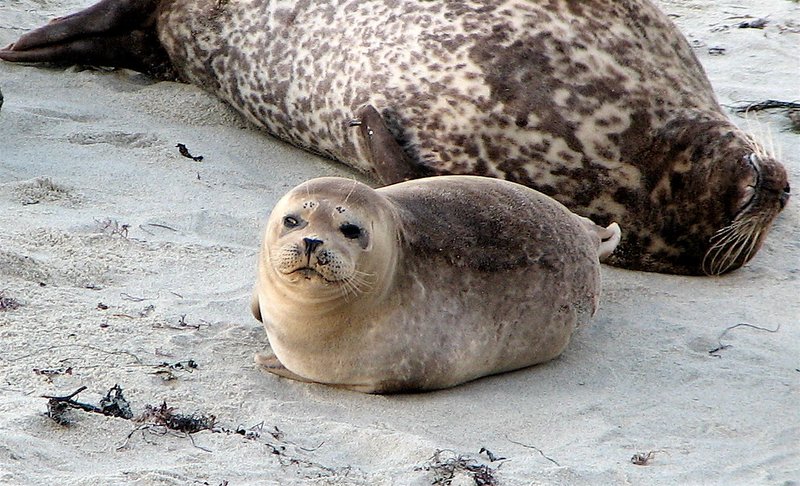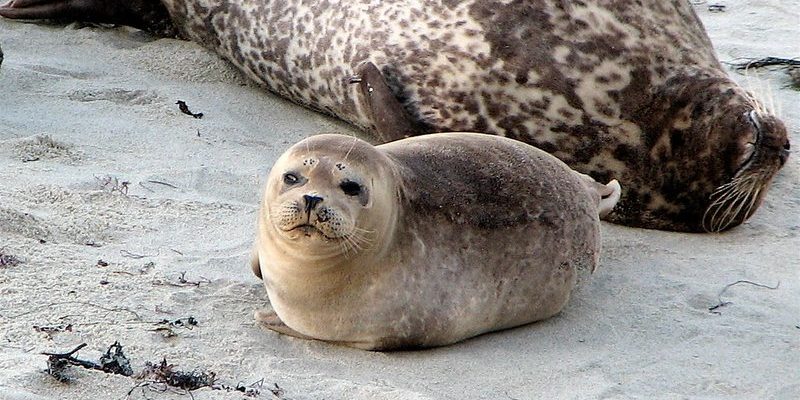
So, whether you’re planning a trip to observe them in the wild or just want to impress your friends with some cool animal trivia, here are ten facts that will make you appreciate harbor seals even more.
1. They’re Adaptable Swimmers
Harbor seals are true champions of adaptation. They can hold their breath for up to 30 minutes while diving to depths of nearly 600 feet! This makes them skilled hunters, as they often dive in search of fish, squid, and other tasty treats. Imagine holding your breath and swimming underwater, all while being on the lookout for dinner!
These remarkable seals use their front flippers to steer and their back flippers to propel themselves through the water. It’s like they’re using a combination of a kayak paddle and a motorboat! When swimming, their bodies streamline beautifully, making them look like torpedoes darting through their underwater playground.
2. They Have Unique Spots
One of the coolest things about harbor seals is their individual markings. Just like how we all have unique fingerprints, each harbor seal has its own set of spots and patterns. This makes it easy for researchers and wildlife enthusiasts to identify and track them.
Having these distinctive markings might be nature’s way of adding a little personality to these animals. Imagine being on a beach and spotting a seal with a heart-shaped mark on its side—how cute is that? Plus, these spots can change over time, adding even more intrigue to their identities!
3. They’re Vocal Communicators
Ever heard a harbor seal? Their vocalizations are like a rich tapestry of sounds, including grunts, barks, and even snorts! They use these sounds to communicate with each other, especially during mating season. It’s like they’re having a conversation about who gets to sunbathe on the best rock.
Interestingly, these sounds can carry over long distances in water. You might be wondering how they do it—well, sound travels much better in water than in air, which is why these vocalizations can reach other seals even when they’re quite far apart.
4. They’re Master Pup Parents
The parenting instincts of harbor seals are pretty impressive. Female seals give birth to a single pup each year, typically in the spring or summer. These pups are born with a thick layer of blubber that helps keep them warm, which is crucial since they can’t swim immediately after birth.
Mom and pup often stay on isolated beaches, where the mother can keep a watchful eye on her little one. The bond is strong—moms often feed their pups for about six months, teaching them the ropes of life in the water. It’s just like how our parents help us learn essential skills!
5. They Can Live Up to 30 Years
Life expectancy for harbor seals can reach around 30 years, although many live slightly shorter lives due to various factors like predation and environmental changes. That’s a long time to enjoy cruising the coastlines and basking in the sun!
You might think about how their life spans compare to other seals. For instance, some species of seals can live into their 40s, while others might only make it to their 20s. Isn’t it fascinating how different species adapt to their environments and life cycles?
6. They’re Sensitive to Changes in Environment
Harbor seals are highly sensitive to pollution and environmental changes. Unfortunately, human activities can have a big impact on their habitats. For example, habitat destruction, pollution, and climate change can drastically affect their food sources and breeding grounds.
It’s not just about the seals, either. These changes can ripple through the entire ecosystem, affecting other marine life too. Understanding this connection helps us recognize our responsibility in protecting the oceans and their inhabitants.
7. They’re Not True Seals
You might be surprised to learn that harbor seals belong to the family of phocids, which are known as “true seals.” This comes down to some anatomical differences, like their lack of external ear flaps and their unique way of moving on land. While they can’t move as gracefully on land as sea lions or other types of seals, they absolutely shine in the water!
So, when watching a harbor seal flop around on the beach, think of it as their quirky dance moves that keep you entertained. Their land agility may not win any ballet competitions, but it’s part of their charm!
8. They’re Found in Many Locations
Harbor seals have a wide range, found along the coasts of the North Atlantic and North Pacific Oceans. You can spot them basking on rocks, beaches, and even floating on ice in colder regions! This adaptability to various environments shows how well they can thrive.
In major cities like San Francisco, they have even made themselves at home, often seen lounging near piers and marinas. This is a perfect example of how wildlife can coexist with urban development, reminding us to appreciate nature in our backyards.
9. They Play an Important Role in the Ecosystem
Harbor seals are a vital part of their marine ecosystem. By feeding on fish and invertebrates, they help maintain a balanced population of these species. Think of them as nature’s way of keeping things in check.
Their presence also provides food for larger predators, like sharks and orcas, creating a food web that supports a diverse marine life. When one species thrives, others benefit too; it’s a delicate dance of life beneath the waves.
10. They’re a Conservation Success Story
Thanks to conservation efforts, harbor seals have made a strong recovery in many areas. Over the years, laws protecting marine mammals have helped mitigate some of the threats they face. It’s a great example of what we can achieve when we work together to protect wildlife.
It’s inspiring to think about how local communities and organizations are actively engaged in protecting these seals and their habitats. When you see harbor seals thriving, it’s a reminder of how efforts to safeguard our planet can lead to positive change.
In conclusion, harbor seals are more than just cute animals lounging by the seaside. They’re fascinating creatures with unique adaptations, important roles in their ecosystems, and compelling stories of resilience. Next time you spot a harbor seal on the shore, you’ll appreciate their charm even more, knowing just how incredibly special they are!

